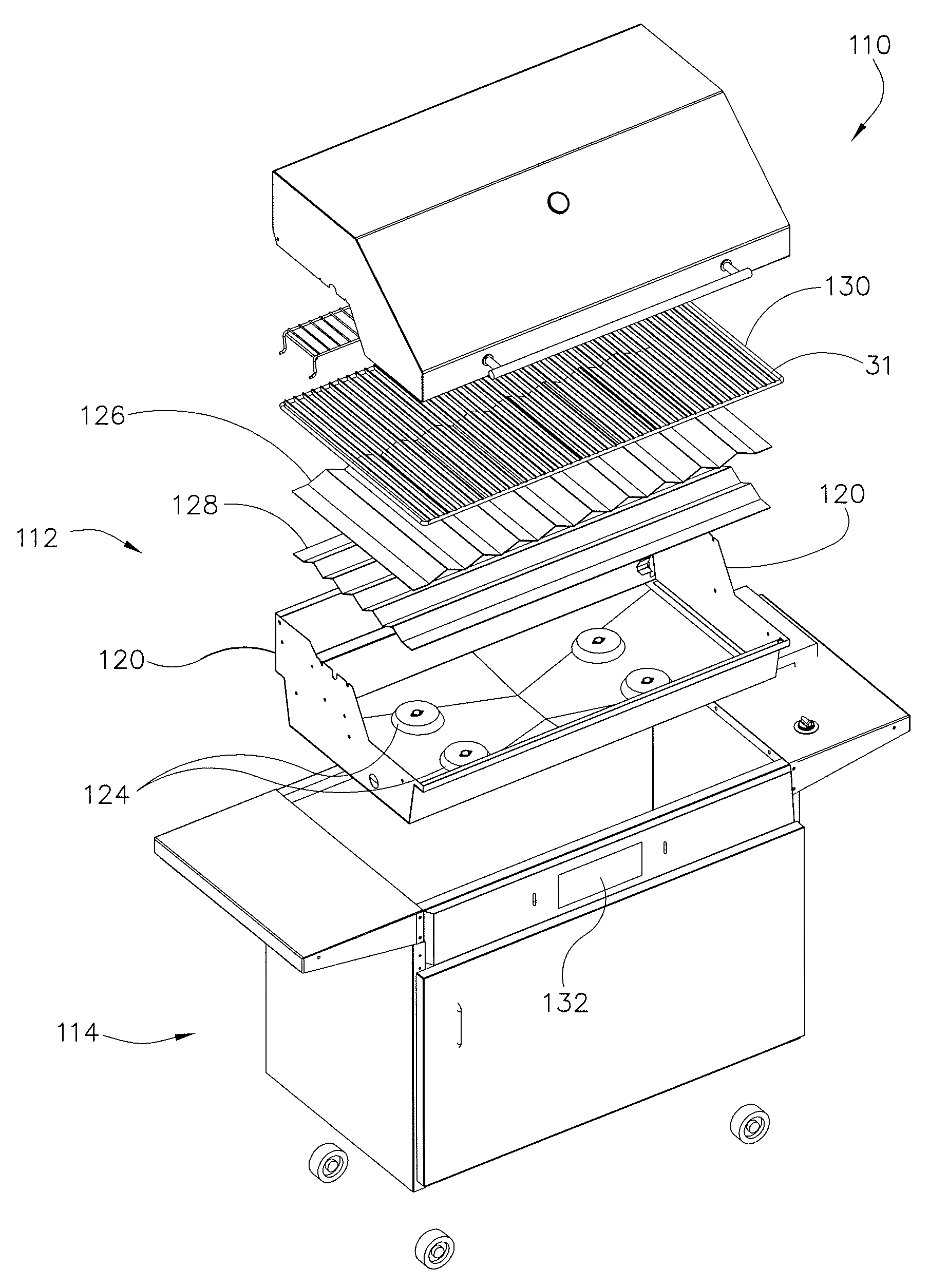However, there are a number of drawbacks in using
charcoal grills.
One drawback is the increased potential for flaming up due to greases, oils, and similar flammable liquids dripping onto the hot coals.
Furthermore, there typically is a long startup process as well as longer operating times needed to properly cook on these grills.
Modern gas grills may overcome some of the problems with charcoal grills but have their own set of drawbacks.
Some gas grill manufacturers put a
single plate with various-sized holes underneath the cooking surface but this method just causes heat to concentrate near the larger holes.
In essence, the heat goes through the large holes unhindered but is limited when trying to go through the small holes.
The result is hot spots on the cooking surface and therefore uneven cooking.
This
single plate design results in basically an oven environment, which does not permit flavoring of the items being cooked, nor does it offer any method for ease of use or cleaning.
One problem is that if not protected from above,
grease and other liquids may fall on to the burner, where the heat and
flame burn the
grease causing a
flare up.
This burning also causes a buildup of carbon and burned
grease residue on the burner to the point that they will fail to operate over time.
There are several other problems that may arise when using long-type burners.
For example, spiders, insects or other debris may get into the burners and inhibit proper operation.
However, the pores of
lava rocks trap fluids and food creating an unsanitary condition with a potential for insects and
bacteria.
Furthermore, the accumulated buildup of grease, food and charred items can block the passage of heat.
Some manufacturers have attempted to solve this problem by using bricks instead of
lava rocks to control the heat and temperature, but have encountered many of the same problems as with
lava rocks.
These inverted V plates direct fluids away from the heating elements but typically become very hot.
This, in turn, causes liquids to sizzle and evaporate rapidly upon contact with the
flavor bars and end up leaving behind a buildup.
Also, these
flavor bars were not designed for any kind of cleaning.
Instead, they must be removed and replaced when they no longer function properly.
However, with the typical gas grill, there is no way to safely or easily adjust the cooking surface, and therefore the cooking temperature.
An additional problem with existing gas grills is that the typical large and long heating elements provide limited control of surface temperatures.
However, these U-shaped elements, long single burner elements, and four- or five-element arrangements are not being used to control heat and surface temperatures.
At low temperature settings, the flame may be so small that just a small amount of
air movement causes the flame to go out.
Another problem with gas barbecue grills is the ability of a typical user to properly assemble the grill.
Poor installation instructions coupled with long
assembly times contribute to this problem.
One typical design of a gas grill has a frame and components fastened only with screws that if improperly installed, can cause structural weaknesses.
Furthermore, over time, even properly installed fasteners can
rust and lose holding power with the result being weakened grills that may eventually fall apart.
However, stainless steel grill components are sometimes difficult to assemble due to the
hardness of the
metal causing screws to not attach properly or to strip the threads of the screw or hole.
Another problem with present grills is the inability to add features to them at a later time.
This is especially a problem with high-end units.
For example, if a
consumer does not have enough money to purchase a high-end unit, he must either wait or purchase a unit with less functionality and features.
Existing rotisserie systems for gas grills have a number of problems.
For example, if an uneven load is placed on the rotisserie shaft, the item may cook unevenly or the motor may stall.
Furthermore, the uneven load may cause the motor to run faster if the load is rotating downwards and slower if the load rotating upwards.
This obviously creates problems with
food quality as well as problems with the motor including popping off the
assembly or lifting off the attachment points on the grill.
A still further problem with current gas grills is with the burner
ignition system.
Furthermore, when lighting a grill, the igniters continually fire sparks until the burner elements are lit.
Once the burner is lit, the buildup of gas ignites causing the user to see and feel a bang.
A further problem with a grill having large burners or one that produces high BTUs, is that a standard tank of
propane (“LP”) does not last for very long.
However, there currently is no kit that can easily change a grill from LP to
natural gas.
A further problem exists in that no present grill accurately monitors the amount of fuel left in the tank and notifies the user accordingly.
Mechanical methods have been used to show the weight of the tank, but tanks differ in weight from manufacturer to manufacturer so these methods are inherently inaccurate.
A further problem with present grills involves the collection of ash, grease and other drippings in special collection trays.
Replacement trays are not readily available in stores and typically only available directly from grill manufacturers.
 Login to View More
Login to View More  Login to View More
Login to View More 


